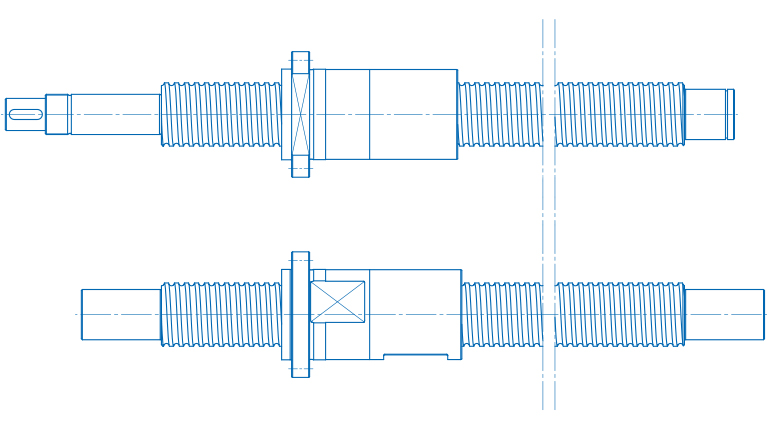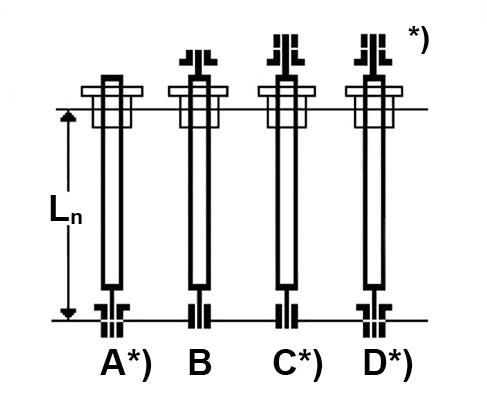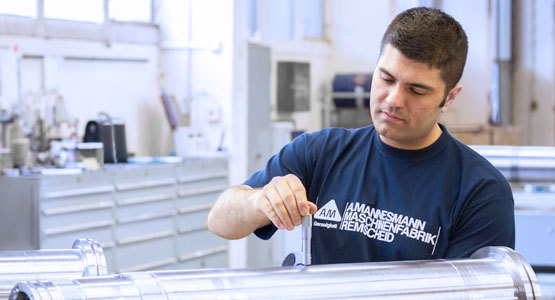Overview of Ball Screws for Heavy-Load Applications
If the axial load exceeds the load bearing capacity of a precision ball screw that was designed according to generally applicable regulations, then the application usually is a heavy load.
This exceptional load can often be avoided by switching to a larger nominal diameter or a larger ball diameter. If this is not possible for structural or manufacturing reasons, corresponding design measures must be taken so that even a supposedly insufficient ball screw can withstand this high load.
Heavy-load applications include all the applications where the load of the ball screw is about 60 - 70% of the dynamic load rating. Dynamics usually does not play any role or only a minor role so that these ball screws can achieve an acceptable usage duration. With such low movement speeds, accelerations and decelerations, heavy-load ball screws can usually also be considered as a quasi-static application and designed according to the viewpoints of a static load. However, the static structural safety (ratio of static load bearing capacity to the load) should not be undercut by 3.
High loads and high operating speeds may lead to an unacceptable service life of a ball screw!
If the effective axial forces exceed the usual load bearing capacity of a certain ball screw installation size, a wear-induced failure usually occurs already after a short period of use. If no larger ball screw is used, then particularly sturdy ball screws are required that can also transfer these high specific forces safely and reliably for a long time.
High Flexibility in Application
A.MANNESMANN has developed ball screws for heavy-load applications with exceptional load capacity and durability due to the structural measures precisely tailored to this task. Special ball recirculation systems and nut designs as well as special ball arrangements make it possible to use considerably more balls in the load-bearing loaded turns than in normal applications. The ball sizes and the ball raceway profiles were adapted to this demanding load.
Application Areas
Heavy-load ball screws are designed for extreme loads. They are frequently used in presses, die casting machines, plastic injection molding machines, lifting equipment, material testing machines, robots or power units. They are characterized by high bearing loads with long travels and high acceleration combined with a long service life. They offer high dynamics despite the masses to be moved.
The ball screws from A.MANNESMANN for the heavy-load applications are optimally equipped for exceptionally high weight loads.
Economical advantages
- Lowest cost standard version
- Extremely high speeds
- High peak loads
- Low power loss
- Long service life
- Excellent energy efficiency
- High long-term durability / service life
- Maximum long-term precision
- Maximum possible machine availability
- Perfected wear resistance due to nitrided spindle
- Economical standard designs or custom production
Technical advantages
- Driven nut
- Minimum residual imbalance of the nut body (balancing quality Q2.5)
- Very high specific load
- Low axial travel speed
- Low speed
- Large ball diameter
- Large ball quantity
- High number of bearing loaded turns
- High load capacity
- High production accuracy of the nut
- Double and triple nuts (3-times)
- Short ball chains
- Single turn return
- High precision and efficiency
- High nut rigidity
- Low friction
- Low idle torque
- The highest power transmission rates
- Extremely high degree of efficiency (up to 98%)
Design
In many cases, special design measures must be taken so that the load can be safely borne by the ball screw. The load direction in all load phases is very important for this purpose. Unlike an alternating stress where the axial load force makes its way from both sides into the ball screw, with a unilateral load of a double nut the preload nut may be done without so that all loaded turns in both halves of the nut are arranged to bear the load and can be used. It is also advisable for a quick and easy assembly to provide a smaller preload nut that keeps the nut system centered and together. In this way, a normal double nut configuration results in a triple nut with extreme load bearing capacity that is mostly used in vertically arranged ball screws, since there is almost always a unilateral load direction here.
Due to the high load (and the associated danger of blocking the balls), the ball chains and the inner friction in the ball screw must be kept as low as possible. This is why heavy-load ball screws are always designed to be friction-optimized.
Friction Optimization Through Deflections
The friction-optimized design of the ball screws can either be achieved through individual turn deflections or through total deflections with separating balls. The use of separating balls benefits the running behavior of the ball screw, but also leads to a loss of load bearing capacity due to the reduced number of bearing balls.
Nut Housing Design
In addition to the power transmission through the balls, the dimensions of the nut housing must also be designed for high loads with heavy-load ball screws. That is why such nuts are usually designed with larger component walls (flange thicknesses) and more mounting screws. Depending on the nominal diameter, very large nut systems are thus created whose total length may be up to 800 mm.
Speed Characteristic Value
The speed characteristic value of dn x n (nominal diameter x speed) < 90,000 applies as a reference value for heavy-load ball screws!
Special Designs
A.MANNESMANN supplies these precision ball screws for heavy-load applications in the nominal diameters of 63, 80, 100, 125 and 160 mm with all the common thread pitches and in the accuracy classes better than IT 5.
Of course as a manufacturer, we also produce special diameters. Please just send us your inquiry.

Driven nut and spindle on a ball screw
Characteristic Values of the Ball Screws
In addition to the dimensions, the load ratings, the nut rigidity and the idle torque are the classifying characteristic values of ball screws. The load ratings describe the load bearing capacities of the ball screw during movement (dynamic) and at rest (static). The dynamic load rating is also the basis for calculating the service life.
The nut rigidity is the measure for the axial force, which is required for deformation in the ball transition contact. The idle torque is the characteristic value for the internal system friction. Together with the nut rigidity, the preload can also be closed via the idle torque.
You will find the characteristic values in the technical data sheet of each ball screw.
Rotatory Mass Moment of Inertia
The rotatory mass moment of inertia (Js) of the spindle is usually required for designing the motor. With driven solid spindles, this (with a good approximation neglecting the thread geometry) corresponds to the cylindrical spindle body with respect to its axis of rotation.
Here the ball contact diameter dc on the spindle with the 4th power, the spindle length ls and the density of the spindle material rs are decisive. The mass moment of inertia Js is usually specified in kgcm2. If the rotatory mass moment of inertia Js is related to the spindle length of one meter, then it can easily be converted by multiplying the ratio of the existing spindle length with one meter.
Spindle Torsion
The spindle is normally driven by a motor. The motor's drive torque is guided through the spindle to the nut and there converts into an axial force. In the slim spindle, this results in a torsion due to the torsional moment that exists. The torsion length, the torsion angle and therefore also the torsional rigidity depend on the axial nut position on the spindle. Since this can change variably in operation due to the axial displacement, the torsional rigidity is also not a constant characteristic value.
The maximum torsional stress of the spindle (can usually also be assumed to be a circular full cross-section) can be determined from the torsional moment or torque (T) and from the polar modulus of resistance of the ball screw spindle (Wps) or the spindle diameter.
The torsion angle (torsional angle) is dependent on the spindle length or on the position (I) where the torque acts and on the shear modulus (G) of the spindle material. To calculate the torsional angle, the moment of area of the 2nd order (Ips) and the torsional moment (T) are also required.
Since the effective position (I) varies depending on the axial travel movement of the nut, the torsional angle (j) is also not a constant value, but rather is a function of the length (I). However, torsional angle is also directly dependent on the time variation of the effective torque, whereby it is also to be seen as a function of time. That is why torsional vibrations that temporally vary depending on the torsion are created, which also act in the axial direction through the ball screw.
Tensile and Compressive Load
In addition to the torsional load, a driven spindle is mainly loaded by tension or pressure. In both cases, the tensile or compressive strength of the spindle are the load limit values.
When evaluating the load, it is important to take the correct "smallest" spindle cross section into account. Only the cross-section that lies in the spindle's distribution of forces is relevant for determining the tension. With the tensile load, the determining spindle cross section usually does not lie in the area of the ball screw, but rather in the area of the mounting thread of the bearings. The buckling stability is also to be noted, since there is a risk of buckling in the event of a compressive load on particularly long spindles.
Characteristic Value Calculations
As part of our service, we offer you the calculation of the most important characteristic values. We would like to support you in your planning from an early stage.
Get in touch with us by sending an e-mail to salesamannesmannde with the subject "Characteristic value calculation" or by phoning us at +49 2191 989-0 and give us the following parameters of your desired ball screw:
- Nominal diameter d0 [mm]
- Pitch P [mm]
- Ball diameter DK [mm]
- Spindle length Ln [mm]
- Bearing selection: Bearing A, bearing B, bearing C, bearing D

*) Directionally stable clamping
Direct to our service
Your request to us
Use our professional competence to develop the best solution. Our engineers can be reached directly under
+49 2191 989-200
Downloads
In our Download Center, you will find all of the information that we provide you as files for downloading, arranged by category.
Downloads for this Product

ball screws folder 8.94 MB

Ball_screws_Precision_ground_new 0.99 MB

characteristics ball screws 16.00 KB

company profile 478 KB

enquiry ball screws 1.90 MB

telescopic ball screws 7.80 MB

Zertifikat_DIN_EN_ISO_9001 1.49 MB
Direct to our service
Your request to us
Use our professional competence to develop the best solution. Our engineers can be reached directly under
+49 2191 989-200


